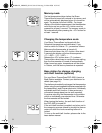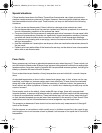12
Special situations
Clinical studies have shown the Braun ThermoScan thermometer can obtain accurate tem-
perature measurements on persons of all ages. However, there are special situations when an
ear thermometer should not be used. These include, but may not be limited to the following
situations:
• Do not use an ear thermometer if there is blood or drainage in the external ear canal.
• An ear thermometer should not be used on a patient who exhibits symptoms of an acute or
chronic inflammatory condition of the external ear canal.
• Common situations like the presence of moderate amounts of cerumen in the ear canal, otitis
media and tympanostomy tubes do not significantly impact temperature readings. However,
complete ear canal occlusion due to cerumen can result in lower temperature readings.
• For persons using hearing aids or ear plugs, remove the device and wait 20 minutes prior to
taking a temperature.
• Use the untreated ear if prescription ear drops or other ear medications have been placed in
the ear canal.
• Patients who have deformities of the face and/or ear may not be able to have a temperature
taken with an ear thermometer.
Fever facts
Many persons may not have an elevated temperature even when they are ill. These include, but
are not limited to infants under 90 days of age, persons taking steroids, antibiotics or antipyretics
(acetaminophen, ibuprofen, aspirin), persons with compromised immune systems, including the
elderly or persons with some chronic illnesses.
Fever is described as an elevation of body temperature over an individual’s «normal» temper-
ature.
An elevated temperature or fever is often viewed as a danger sign. In fact, a fever can be very
beneficial, and helps our immune system work more effectively. A fever should be evaluated
along with other physical symptoms. With the exception of newborn infants, the presence of
fever, without any other symptoms of illness, or in a child who is behaving normally may not be
cause of concern.
Some people, such as the elderly, infants under 90 days of age, those with compromised
immune systems, or persons who take steroids for example are often unable to build a response
to illness or environmental conditions. These individuals may not have a fever when they are ill,
or their elevated temperature may be lower than expected for the severity of their illness. Other
medications such as anti-inflammatories and some analgesics may also mask fever.
The presence or absence of fever should not be used as the only measurement of the signifi-
cance of the illness.
Febrile seizures, or convulsions, which usually occur in children six months to six years of age,
are thought to occur not because a fever is present, but because of the rapid rise of the child’s
temperature.
6021221_PRO4000_S4-46 Seite 12 Dienstag, 21. März 2006 10:24 10


















